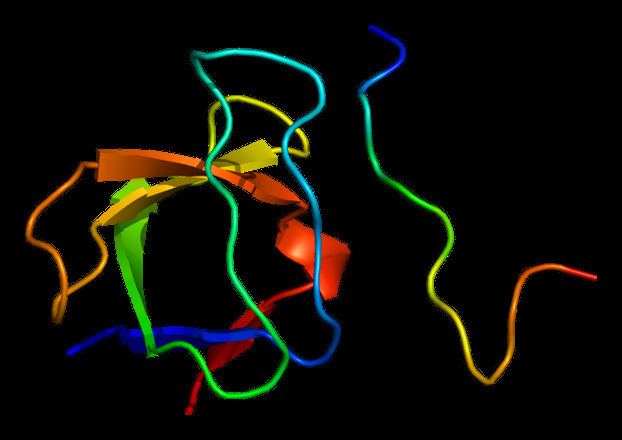Entrez 2534 | Ensembl ENSG00000010810 | |
 | ||
External IDs MGI: 95602 HomoloGene: 48068 GeneCards: FYN | ||
Proto-oncogene tyrosine-protein kinase Fyn (p59-FYN, Slk, Syn, MGC45350, Gene ID 2534) is an enzyme that in humans is encoded by the FYN gene.
Contents
Fyn is a 59-kDa member of the Src family of kinases typically associated with T-cell and neuronal signaling in development and normal cell physiology. Disruptions in these signaling pathways often have implications in the formation of a variety of cancers. By definition as a proto-oncogene, Fyn codes for proteins that help regulate cell growth. Changes in its DNA sequence transform it into an oncogene that leads to the formation of a different protein with implications for normal cell regulation.
Fyn is a member of the protein-tyrosine kinase oncogene family. It encodes a membrane-associated tyrosine kinase that has been implicated in the control of cell growth. The protein associates with the p85 subunit of phosphatidylinositol 3-kinase and interacts with the fyn-binding protein. Alternatively spliced transcript variants encoding distinct isoforms exist.
History
Fyn is a member of the Src-family of kinases (SFK), the first proto-oncogene to be identified. The discovery of the Src-family in 1976 led to the Nobel prize for medicine in 1989 for J.M Bishop and E.M. Varmus. Fyn was first identified in 1986 as Syn or Slk through probes derived from v-yes and v-fgr. A common feature of SFKs is that they are commonly upregulated in cancers. Fyn is functionally distinct from its family members in that it interacts with FAK and paxillin (PXN) in the regulation of cell morphology and motility.
Function
Fyn is a protein, present in the signaling pathway of integrins, which activates ras. Fyn is a tyrosine-specific phospho-transferase that is a member of the Src family of non-receptor tyrosine protein kinases. (This family also includes Abl, Src, focal adhesion kinase and Janus kinase.) Fyn is located downstream of several cell surface receptors, commonly associated with neuronal development and T-cell signaling. When fyn is activated it causes downstream activation of molecular signals that drive processes crucial to growth and motility of cells. Fyn is primarily localized to the cytoplasmic leaflet of the plasma membrane, where it phosphorylates tyrosine residues on key targets involved in a variety of different signaling pathways. Tyrosine phosphorylation of target proteins by Fyn serves to either regulate target protein activity, and/or to generate a binding site on the target protein that recruits other signaling molecules. Interestingly, Fyn also has the ability to serve as a tumor suppressor. When this normal biology is compromised, the altered Fyn becomes involved in the neoplastic transformation of normal cells to cancerous ones following the pathway from pre-invasive, to invasive, and ultimately metastasis.
Role in signaling pathways
An understanding of the role of fyn in normal biology is crucial to the understanding of its role in cancer, as cancer is the dysregulation of these normal pathways. Knowing which pathways involve Fyn will provide key insight for the development of potential pharmacologic agents to attenuate this uncontrolled signaling.
At least three tools have been useful in discerning a requirement for Fyn function in a particular signaling system:
Using these tools, a requirement for Fyn has been shown for the following signaling pathways: T and B cell receptor signaling, integrin-mediated signaling, growth factor and cytokine receptor signaling, platelet activation, ion channel function, cell adhesion, axon guidance, fertilization, entry into mitosis, and differentiation of natural killer cells, oligodendrocytes and keratinocytes.
Interactions
FYN has been shown to interact with:
Role in Cancer Biology
The Src family of kinases is commonly associated with its role in “invasion and tumor progression, epithelial-to-mesenchymal transition, angiogenesis, and development of metastasis,” all hallmarks of cancer progression. Fyn’s normal function in cellular growth and proliferation has the potential to be exploited in the progression and metastasis of cancer cells. Overexpression of Fyn has been found to drive morphologic transformation in normal cells and increase “anchorage-independent growth and prominent morphologic changes.”
Fyn overexpression has been studied in relation to the following cancers: prostate cancer, glioblastoma multiform, squamous cell carcinoma of the head and neck, pancreatic cancer, chronic melogenic leukemia, and melanoma. This overexpression triggers a promotion of “anti-apoptotic activity of Akt” in prostate cancer, meaning that these cells have gained the ability to avoid the normal cell death pathways (a common hallmark of cancer). Additionally, in glioblastoma multiform, Src and Fyn have been found to be “effectors of oncogenic EGFR signaling” which has led to tumor invasion and cancer cell survival.
Fyn’s normal role in cell migration and adhesion enables it to utilize the normal cell biology of integrin and FAK for cancer growth. Normal integrin is a cell surface receptor that interacts with the extracellular matrix to send signals influencing cell shape and motility. Normal FAK is a tyrosine kinase that gets recruited to focal adhesion sites and plays a key role in directed cell movement. These normal pathways plan a key role in “mediation of Fyn transmitted cellular events impacting shape and motility.” A compromised version of this pathway would enable cancer cells to change shape and motility, increasing the possibility for advanced invasion and metastasis. Additional pathways under investigation regarding Fyn’s role in cancer progression include: the Rac and Rho family of GTPases, Ras, Erk, and MAPK.
Because of this, Fyn has been a common target for anti-cancer therapeutic research. The inhibition of Fyn (like other SFKs) results in decreased cell growth. Furthermore, “expression of kinase-dead-Fyn (KD-Fyn), a specific competitor of endogenous Fyn,” was found to reduce the size of primary tumors in mice. Specifically targeting the unique identifying properties of Fyn as well as inhibiting FAK and PXN has the potential to create a very effective molecularly targeted combination cancer therapy.
